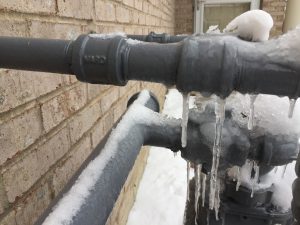Tips to Avoid Frozen Plumbing in Winter: Expert Tips
Tips to Avoid Frozen Plumbing in Winter: Expert Tips
Blog Article
In this article underneath you might get some dependable guidance on the subject of Winter Plumbing Precautions: Preventing Frozen Pipes.

Cold weather can damage your pipes, particularly by freezing pipelines. Right here's just how to stop it from occurring and what to do if it does.
Introduction
As temperature levels drop, the threat of icy pipelines boosts, potentially causing costly repairs and water damages. Understanding just how to stop frozen pipelines is essential for homeowners in chilly environments.
Comprehending Icy Pipelines
What triggers pipelines to freeze?
Pipes ice up when revealed to temperature levels below 32 ° F (0 ° C) for extended durations. As water inside the pipelines freezes, it increases, taxing the pipe wall surfaces and potentially triggering them to rupture.
Threats and damages
Frozen pipes can result in water supply disruptions, home damage, and costly repair work. Burst pipelines can flood homes and create extensive architectural damage.
Signs of Frozen Pipes
Determining icy pipelines early can stop them from breaking.
Just how to determine icy pipelines
Seek lowered water flow from taps, unusual smells or noises from pipes, and noticeable frost on exposed pipes.
Avoidance Tips
Insulating prone pipelines
Wrap pipes in insulation sleeves or utilize warmth tape to protect them from freezing temperatures. Focus on pipes in unheated or outside locations of the home.
Home heating strategies
Maintain indoor rooms sufficiently heated up, particularly areas with plumbing. Open cabinet doors to allow cozy air to flow around pipelines under sinks.
Securing Outside Plumbing
Garden tubes and outside taps
Separate and drain pipes yard hose pipes prior to wintertime. Install frost-proof spigots or cover outside taps with insulated caps.
What to Do If Your Pipes Freeze
Immediate actions to take
If you think icy pipes, maintain taps open to relieve stress as the ice thaws. Make use of a hairdryer or towels taken in hot water to thaw pipes gradually.
Long-Term Solutions
Structural changes
Take into consideration rerouting pipes far from outside walls or unheated locations. Add added insulation to attics, cellars, and crawl spaces.
Updating insulation
Purchase top quality insulation for pipelines, attic rooms, and walls. Correct insulation assists keep consistent temperatures and lowers the threat of icy pipelines.
Final thought
Stopping frozen pipes requires proactive steps and quick responses. By understanding the reasons, indicators, and safety nets, homeowners can shield their plumbing throughout cold weather.
6 Proven Ways to Prevent Frozen Pipes and Protect Your Home
Disconnect and Drain Garden Hoses
Before winter arrives, start by disconnecting your garden hoses and draining any remaining water. Close the shut-off valves that supply outdoor hose bibs and leave the outdoor faucet open to allow any residual water to drain. For extra protection, consider using faucet covers throughout the colder months. It’s also important to drain water from any sprinkler supply lines following the manufacturer’s directions.
Insulate Exposed Pipes
Insulating your pipes is an effective way to prevent freezing. Pipe insulation is readily available at home improvement stores and is relatively inexpensive. Pay close attention to pipes in unheated areas such as the attic, basement, crawl spaces, or garage. Apply foam insulation generously to create a buffer against the cold. You can also wrap your pipes in heat tape or thermostat-controlled heat cables for added warmth.
Seal Air Leaks
Inspect your home for any cracks or openings that could let in cold air. Seal any holes around the piping in interior or exterior walls, as well as the sill plates where your home rests on its foundation. Additionally, make sure to keep your garage door closed unless you’re entering or exiting. Leaving it open creates a significant air leak that can lead to frozen pipes.
Allow Warm Air Circulation
During cold snaps, it’s essential to allow warm air to circulate evenly throughout your home. Leave interior doors ajar to promote better airflow. Open kitchen and bathroom cabinets to help distribute heat consistently around the rooms. If you have small children or pets, be sure to remove any household chemicals or potentially harmful cleaners from open cabinets for safety.
Let Faucets Drip
A small trickle of water can make a big difference in preventing ice formation inside your pipes. When temperatures drop significantly, start a drip of water from all faucets served by exposed pipes. This continuous flow helps prevent the water from freezing. Additionally, running a few faucets slightly can relieve pressure inside the pipes, reducing the chances of a rupture if the water inside does freeze.
https://choateshvac.com/6-proven-ways-to-prevent-frozen-pipes-and-protect-your-home/

We had been shown that editorial about 6 Ways to Prevent Frozen Pipes through a friend on our other blog. Do you know somebody else who is in the market for the niche? Why not share it. Thanks for taking the time to read it.
Book Your Installation Report this page